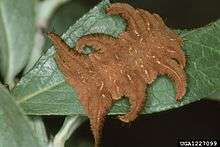Phobetron pithecium
Phobetron pithecium, the hag moth, is a moth of the family Limacodidae. Its larva is known as the monkey slug.
| Phobetron pithecium | |
|---|---|
 | |
_Moth_(Limacodidae_-_Slug_Caterpillar_Moths).jpg) | |
| Scientific classification | |
| Kingdom: | |
| Phylum: | |
| Class: | |
| Order: | |
| Family: | |
| Genus: | |
| Species: | P. pithecium |
| Binomial name | |
| Phobetron pithecium (JE Smith, 1797) | |
Lifecycle
One generation a year occurs in the north, but two or more happen in the southern United States.[1]
Larva
The larva is distinctive, with no close analogues, although it may be mistaken for the shed skin of a hairy spider or leaf debris. It has six pairs of curly projections, three long and three short from the flattened body, each densely covered in hairs. According to David L. Wagner, who experimented on himself, the hairs do not sting, contrary to popular belief. However, susceptibility can vary among humans and it may produce a reaction in some people. Some members of the family Limacodidae do sting. Like all limacodids, the legs are shortened and the prolegs are reduced to suction cups. The "arms" can fall off without harming the caterpillar. Maximum length of larvae is 2.5 centimetres (0.98 in).[1]
It is solitary and is not a very significant agricultural threat, but it is a common sight in orchards.
Pupa
This species pupates in a cup-shaped cocoon with a circular escape hatch.
Food plants
Larvae eat a variety of deciduous trees and shrubs, such as apple, ash, birch, cherry, chestnut, dogwood, hickory, oak, persimmon, walnut, and willow.[1]
References
- Wagner, David L. (2010). Caterpillars of Eastern North America. Princeton University Press. p. 44. ISBN 978-1400834143.
External links
| Wikimedia Commons has media related to Phobetron pithecium. |
- BugGuide Photos
- Moths of Maryland Large photos of adults
.jpg)